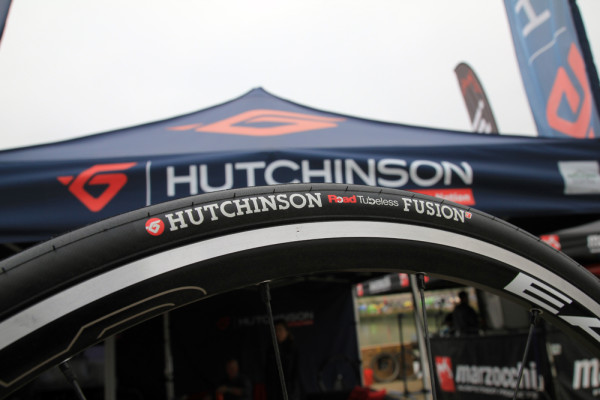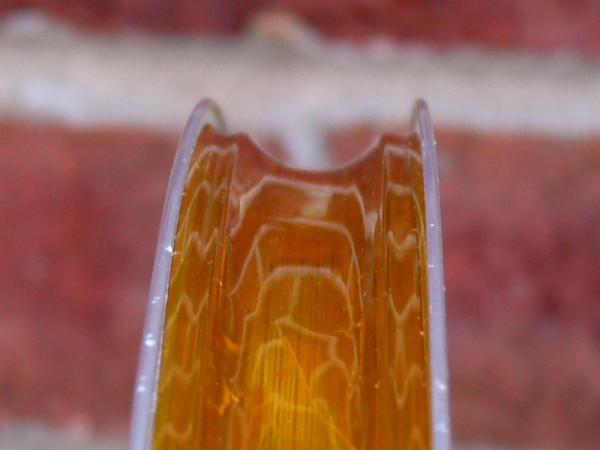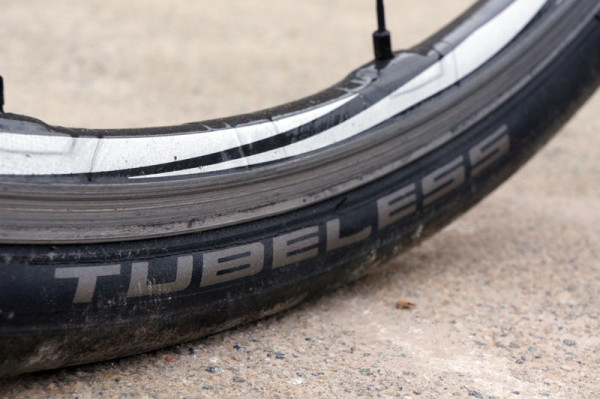Part One of our Road Tubeless series seemed to spur a lot of discussion, especially around the statement that a Road Tubeless standard does not exist. Most of us believe if a product says “Road Tubeless” on the side, it will work with other items that say the same.
Unfortunately, that’s not necessarily the case, and a lot of this confusion has come from the companies themselves, using the common term -either with caps (Road Tubeless) or without (road tubeless)- to market dissimilar products. So we checked in with the producers of the most common products and asked them about the future of Road Tubeless. Do they see standardization coming? Is there any standard now?
Take a look inside for a comprehensive exploration of where Road Tubeless stands today…

We’ll start this off with Hutchinson, arguably the originator of the idea.
BIKERUMOR: Your Road Tubeless method with Shimano – is this an industry-wide standard that anyone has access to? How would one gain access to the technical documents that would outline the standard?
HUTCHINSON: The first system was collectively developed by Hutchinson and Shimano in 2006. Obviously the rim by Shimano and the tire tech by Hutchinson. The specifications for the rim have been administered to prospective manufacturers by Hutchinson. If a rim or wheel manufacturer wants to produce a compatible wheel, Hutchinson handles the technical details with the rim developer.

IS THERE, OR WILL THERE BE A STANDARD?
BIKERUMOR: An overall Road Tubeless standard does not exist in the industry. The closest thing to it appears to be Hutchinson’s certification process:
EASTON: Hutchinson has established a specification for critical rim dimensions and tolerances that allow the rim and tire to work together. These dimensions and tolerances allow the tire to be easily install and removed, as well as seated with relative ease. It also allows the bead to lock into place so the tire does not burp and to pass the leak down test required for the Hutchinson road tubeless.
HUTCHINSON: Regarding standards, there is not an official standard like there was at the beginning of MTB with UST. But the (numerous brands we’re working with) obviously demonstrates that there’s been enough collaboration with wheel manufacturers and Hutchinson to establish a standard via technical participation. Although there are other manufacturers participating in the Road Tubeless sector, we can imagine their involvement began after inspecting and dissecting the first Hutchinson Road Tubeless tires from 2006. In terms of compatibility, there are certain materials and technical attributes required to produce a road tubeless tire, angular bead profile, carbon beads, etc. Although there may be some shared materials and technology between brands and systems, Hutchinson advises using the approved rims and wheels (Ed. – There is a list of Hutchinson’s approved rims at the end of the article) with their tires to insure the highest standards of fit, function and performance.
BIKERUMOR: Basically, that means it’s more likely a rim will see any sort of “certified Road Tubeless” claim than a competing tire brand. Tire companies can always reverse engineer a certified rim’s shape into the desired tire bead shape, they just wouldn’t necessarily be able to use the Road Tubeless logo found on Hutchinson’s tires. Beyond that, though, has there been any chatter amongst companies in creating a standard?
IRC: There has been no such movement. We always refer to major wheel manufacturers for safety.
ENVE: While there does not appear to be any attempt for an industry wide adoption of a single road tubeless system, we work closely with the best tire companies in the industry to ensure that our rims meet the dimensional requirements of their tires. The Hutchinson certified specification is the closest thing to a standard that we have in the industry at the moment.
TREK: We definitely have our own internal quality standards for road TLR and are really confident in the user experience and quality (of) our system. The flexibility to chase ideas that come our way, without having to worry about formal standards, or having to develop new ones is nice as we are continually refining and improving products. Taking cues from the MTB world, you see a UST standard, you see some complaints with it -heavy with manufacturing difficulties- and you see some issues with adopting it and a sort of half use of the standard coming out of it. Flexibility is nice when you are refining and improving products, especially when you have wheel and tire designers working in tandem.
SCHWALBE: Unfortunately, I do not see an industry wide standard ever happening as most wheel manufacturers seem to have different philosophies in making a TL wheel, i.e. Stan’s. We also see this type of philosophy on the MTB side. Road TL tires are all fairly similar in their construction. As a fairly new technology I expect Road TL tires to continue to change, improve and innovate in the coming years. This is a similar process to what we saw on the MTB side years ago after Hutchinson first introduced UST as a design guideline. At first it was the standard and now you are hard pressed to find many companies still making UST tires.

IS THERE ENOUGH DEMAND TO JUSTIFY FURTHER DEVELOPMENT?
BIKERUMOR: Do you see enough demand for Road Tubeless to put more R&D into this area and build new products?
HUTCHINSON: Road Tubeless sales have always been an important category of our overall tire sales. Since their launch in 2006, RT tire sales have doubled year over year and now constitute about 60% of our (700c) road tire sales, which is about 70% of Hutchinson’s total North American bicycle tire sales. We currently sell every Sector 28 we can get our hands on and this tire has definitely become a “halo” product for Hutchinson…and has converted many a previously RT skeptical cyclist to a Road Tubeless evangelist. But at the same time, there’s a huge amount of brand loyalty between cyclists and their tires that sometimes needs to be overcome in order to try a new technology that your current tire may not offer.
ENVE: Absolutely. We have customers asking us on a daily basis what our opinion is regarding road tubeless and when we will bring it to market. We have both Sales, R&D, and Marketing departments working closely together to better understand the use cases for road tubeless to ensure that when we launch a road tubeless wheel, it will check off all the boxes that are currently preventing road tubeless from taking off. The ultimate goal is that road tubeless becomes as ubiquitous in the optimal road applications as it has for mountain bike.
TREK: Yes! The safety offered by TLR systems and the puncture protection, durability, and riding performance that it allows will see this category grow. Road, fitness, and city are all huge opportunities for TLR.
IRC: Yes indeed, in fact we are planning to develop many more varieties in the road tubeless model. IRC also has three models in cyclocross tubeless tires with market’s attention. IRC is foreseeing more needs not only in racing bicycles but also in commuter and urban bikes market since the tubeless concept is more safe, comfortable and practical.
WHICH TIRES WORK WITH WHICH RIMS?
BIKERUMOR: There are a lot of different options on the market…what works with what?
TREK: We are always going to recommend setting them up as intended. There is a huge advantage of using products that were designed to work with each other. We have put a ton of time, research, and testing into our TLR wheels and TLR tires and the simple solution for best user experience is to stick with what is designed to work together.
SCHWALBE: We worked on developing our system with many different wheel manufacturers, not just DT Swiss. The purpose of this is to make sure our tire works with all TL wheels, not just one company as many other TL tire manufacturers have done. Our construction of a road tubeless tire is very similar to that of Hutchinson, but we use a proprietary bead core material that is extremely strong and flexible compared to the fragile carbon bead core materials used by some other brands.
IRC: IRC road tubeless products are well recognized and acknowledged by major wheel manufacturers and working very well with their “Road Tubeless Wheels”. (Editor’s note: We’ve been testing them and they work great on a variety of tubeless ready road rims)
DT SWISS: From MY2015 forward all DT Swiss wheels are tubeless compatible, meaning tubeless tape and valve are added to every clincher wheel. DT Swiss wheels (offer the) highest flexibility when it comes to the use of different tires; after mounting the tubeless tape and installing the tubeless valve, wheels can be ridden with tubeless tires or – after removing the tubeless valve – with standard tube-type tires, too.

WHAT’S SPECIAL ABOUT THE CONSTRUCTION OF A ROAD TUBELESS TIRE?
BIKERUMOR: What makes a Road Tubeless tire? What changes are you making to the tire over a traditional tubed tire?
SCHWALBE: Our TL road tires is comprised of a few very specific parts that differentiate it from a standard clincher tire. To begin with it utilizes a very specific bead shape with a larger flat area at the bottom of the bead where it contacts the rim to help prevent burping, it also utilizes a much stronger bead core material than our typical clincher tire and tire also receives an additional layer of butyl liner inside the tire, essentially welding the tube and tire together into one component rather than having two separate components. This reduces the friction loss between tire and tube greatly reducing rolling resistance.
IRC: We put the highest priority on safety. The bead must stay and sit firmly on the rim under high pressure and the air leak must be minimized, and not only on the road safety, we also much care about safety on its mounting process. IRC has developed the IRC Tubeless Lever. It is important to make sure that tires should be mounted without damaging rim and tire itself.

WHAT IS SPECIAL ABOUT THE CONSTRUCTION OF A ROAD TUBELESS RIM?
BIKERUMOR: What is the actual difference between a regular rim and a road tubeless rim?
AMERICAN CLASSIC: Our Road tubeless rims are a balance of light and strong with great function as either tubeless ready or with standard tire and tube. (We) designed our rims with a bead barb running along the edge of the bead shelf. When installed, the tire firmly pops into position over the bead barb. The tire bead centers and tightly grips the circumference of the rim creating a sealed environment to hold the liquid sealant without burping.
EASTON: Our Road Tubeless product currently have a sealed tire bed and confirm to the dimensions and tolerances specified by (Hutchinson) Road Tubeless. They also have the bead barb to lock the tire bead into place for a secure rim / tire fit.
ENVE: Essentially there are two major factors that differentiate standard road rims and tubeless rims. For a rim to be tubeless compatible it must be sealed to prevent air from escaping out spoke or valve stem holes, and at the tire rim interface; thus it must be dimensionally matched to those of the tire. Tubeless rims generally feature a locking mechanism that locks the bead of the tire onto the rim so that in the instance of a flat the tire will remain on the rim.
REYNOLDS: For Road Tubeless, the structure of (our carbon rims) is completely different. The way the tire sits in the rim is different than tube type tires – the position of the tire’s bead sits down in the bottom, on the rim bed, rather than pushing up against the bead hook. This is also why it’s not a good idea to try to convert tube-type road tires to tubeless. Tire fit is really the hard part. With tube type tires, you have a wider tolerance for its fit. With tubeless, it’s a much tighter tolerance. Making that particularly tough is that some tire manufacturers have a lot of variance in their bead shapes (from batch to batch), and ETRTO dimensions can be off from tire to tire and brand to brand. So, trying to build a design that accommodates for tire variation is one of the biggest problems for us and the industry in general. We can build a rim with a very tight tolerance, 20x or 30x more precise than tires can be. We did our very best to create a channel design that’s robust and can accommodate as much tire variance as possible.

BIKERUMOR: (to Trek) You might have the only paired Road Tubeless Tire/Rim. Is being both a tire and rim manufacturer an advantage in this area?
TREK: Absolutely! It is a huge advantage. Our wheel teams and tire teams work together in the same room. They share meeting space, ideas, and spend their lunches either eating together, discussing ideas or riding outside together. To tie the development of both TLR tires and TLR wheels that closely together is a huge advantage. They work together to make a full tubeless system: tire, rim, rim strip, and sealant, owning the whole process and developing it as one. We are really fortunate in that regard to be able to offer a complete system.
IS ROAD TUBELESS GOING TO THRIVE?
BIKERUMOR: Road Tubeless has not really caught on like tubeless has in mountain biking. Any ideas why?
SCHWALBE: The road market is very traditional in many ways and much slower to adopt new technologies than we may see with MTB. A lot of people take on the idea of ‘if the system’s not broken, why fix it’. Also, in the past there have been very few TL road wheels, and wheels are typically the last part someone changes on a new bike. In recent years many OE companies have started spec’ing there bike with ‘dual fit’ rims that make switching to tubeless much easier and less costly for the consumer. We have seen exponential growth in the TL road market due to this fact.
EASTON: It took a while for UST / Tubeless to catch on in mountain biking, (because of the) initial lack of choices in tires and wheels, as well as the increase in weight and cost. We are at the point now where more and more tire and wheel brands are at least offering some Road Tubeless product and others like Easton where the majority of the line is compatible. With more tire and wheel choices and the price and weight decreasing consumers can choose their desired combination with little to no penalty while enjoying the benefits of Road Tubeless. Our EC90 Aero 55 Carbon Clincher Road Tubeless is now shipping and we just launched the EC90 SL Carbon Clincher Road Tubeless wheel and will start to ship production in a few months. This is a full Road Tubeless carbon clincher rim with our Fantom rim shape and 19mm inner width, available in both rim brake and disc brake. At Easton we believe in Road Tubeless so as we develop new wheels we work to make them compatible. Of course our wheels can be used with tire and tube if desired, in those cases you still have a lighter offering as you no longer need a rim strip with is a savings of around 40g per wheel set of rotational weight.
ENVE: Simply put, the benefits of mountain tubeless are more readily apparent to mountain bikers than road bikers. Mountain bike tubeless systems have the advantage of tire volume on its side. Larger volume tires require less air pressure, less air pressure means tires are easier to install, seat, and manage. Mountain bikers were and are more likely to deal with regular flat tires than road cyclists so having a tire that was less prone to pinch flats, and that virtually eliminated punctures from thorns and the like by using a little sealant made a world of difference. With more and more recreational cyclists moving towards high volume road tires, we believe the adoption rates and user friendliness of road tubeless will be on the rise. At the pro level, tubulars are still the name of the game due to their light weight, flat resistance, security, and stellar ride quality. Several tire manufacturers such as Schwalbe are producing a tubeless ready tire that rivals the ride performance of the highest end tubulars and clinchers; this will play a key role in getting road tubeless into the top echelons of the sport. At ENVE, we are working closely with these tire manufacturers to ensure that our tubeless road rims pair seamlessly with these tires to ensure performance that is superior to that of a tubed system.
REYNOLDS: We’ve been working very closely with Michelin, Schwalbe and Continental and they’ve been great companies to work with. That’s made a big difference in the development in our road tubeless rims. I think RT is the future, and I think there’ll be a time when tubes completely go away and there’s a generation that has never used a tube just like there are generations that have never used a record player or a landline phone. We’re investing heavily in it. (Editor’s note: Reynolds’ Paul Lew said Conti was actually an early development partner with Shimano but held off, so read into this what you will about what we’ll see from Continental in the near future).
FOOTNOTE:
Hutchinson Approved Rims:
- Alex ACF42
- Alex AT550
- Alex CX30
- American Classic Argent Road Tubeless
- American Classic Argent Road Tubeless Disc
- American Classic Hurricane Road Tubeless
- American Classic Hurricane Road Tubeless Disc
- American Classic Sprint 350 Road Tubeless
- American Classic Victory 30 Road Tubeless
- Campagnolo Eurus 2-Way Fit
- Campagnolo Zonda 2-Way Fit
- Corima Aero + Carbon
- Corima Aero + Winium
- DT Swiss RR 1450
- DT Swiss R 1700
- Easton EA90 RT
- Easton EA90 SL
- Easton EA90 SLX
- Easton EC90 Aero 55
- Easton EA90 XD
- Fulcrum Racing 0 2-Way Fit
- Fulcrum Racing 1 2-Way Fit
- Fulcrum Racing 2 2-Way Fit
- Hutchinson RT1 Carbon
- Reynolds Assault SLG
- Reynolds Attack
- Shimano DuraAce WH- 7850SL
- Shimano DuraAce WH-7900-C24-TL
- Shimano Ultegra WH-6700
Confused? Even from the manufacturers, there is conflicting and confusing information, so we remind users to do their research, and only use products that the manufacturer says are compatible. We don’t mind being guinea pigs here, that’s our job, but we want you to be safe. Our takeaway from all this is that there will likely be a few dominant partnerships and systems from the major players. And most likely they’ll play nice enough with each other but be optimized for their partner brands. You know, kinda like mountain bikes.

